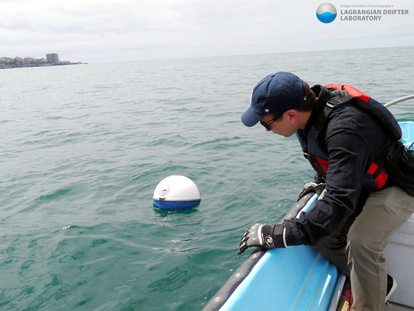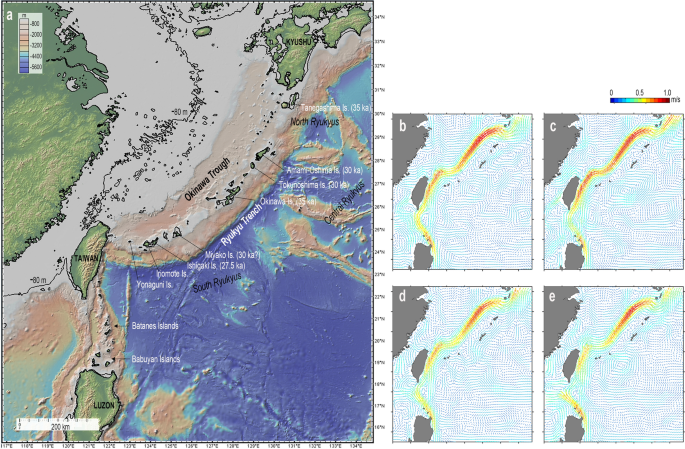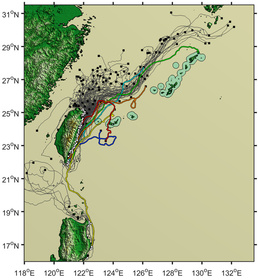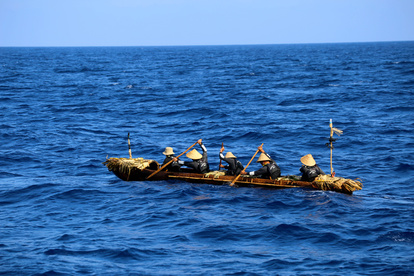これ!面白い。
琉球列島への3万年前の人類到達 偶然の漂着ではない 2020/12/4
約3万年前に琉球列島に住み着いた祖先たちは、黒潮に流されて偶然漂着したのではなく、意図して島へ航海した「開拓者」だった可能性が高い。そんな論文を東京大などのグループが3日、科学誌サイエンティフィック・リポーツに発表した。海洋調査用の漂流ブイの経路などを詳しく分析した結果、「漂流説」が強く否定されたという。
琉球の島々には3万年前ごろの旧石器時代の遺跡が点在し、人が台湾やフィリピン方面から海を渡ってきたと考えられている。人が移住するためには、10万年以上前からほぼ流路が変わっていない世界最速級の海流、黒潮を横切らなければならない。

グループは、海に流して位置や水温などを計測する漂流ブイに着目。米海洋大気局などに集まる世界各地のデータから、1989年から2017年に台湾東岸やルソン島北部から流された138個の経路などを調べた。
大多数は黒潮を横切れず、台湾の北方海上や中国大陸の方へ向かった。黒潮を横断した6個はいずれも台風や強い季節風の影響を受けていた。人が無事に航海するのは難しい気象条件と考えられた。また8個は九州やトカラ列島付近まで達したが、2~3週間かかるため人が舟の上で生き続ける可能性も小さいと思われた。
新しい島で人口を維持するには少なくとも男女計10人程度が必要という。漂流する舟に男女がうまく乗り合わせて島に到達する確率は極めて低いと結論づけた。
一方、ブイの中には台湾などへ再び漂着したものもあった。舟で漂流しながら生還した人が経験を基に航海の知識を身につけ、人々の中に蓄積されたとも考えられるという。
グループは昨年、国立科学博物館が主導した「3万年前の航海 徹底再現プロジェクト」で、5人乗りの丸木舟による台湾から与那国島への航海を成功させている。海部陽介・東京大総合研究博物館教授(前国立科学博物館人類史研究グループ長)は「漂流説がほとんどあり得ないことを、初めて説得力を持って示せた。海を渡った祖先は、意図的な移住に挑戦した開拓者というイメージが適切だろう」としている。
Palaeolithic voyage for invisible islands beyond the horizon
Abstract
How Palaeolithic maritime transportation originated and developed is one of the key questions to understand the world-wide dispersal of modern humans that began 70,000–50,000 years ago.
However, although the earliest evidence of maritime migration to Sahul (Australia and New Guinea) has been intensively studied, succeeding development of Paleolithic maritime activity is poorly understood. Here, we show evidence of deliberate crossing of challenging ocean that occurred 35,000–30,000 years ago in another region of the western Pacific, the Ryukyu Islands of southwestern Japan.
Our analysis of satellite-tracked buoys drifting in the actual ocean demonstrated that accidental drift does not explain maritime migration to this 1200 km-long chain of islands, where the local ocean flows have kept the same since the late Pleistocene.
Migration to the Ryukyus is difficult because it requires navigation across one of the world’s strongest current, the Kuroshio, toward an island that lay invisible beyond the horizon. This suggests that the Palaeolithic island colonization occurred in a wide area of the western Pacific was a result of human’s active and continued exploration, backed up by technological advancement.
Introduction
The rise of voyaging technology beyond nearshore boating was a key for early modern humans to exponentially expand their habitable territory on the globe.
Maritime migration to Sahul (a combined continent of Australia and New Guinea), which occurred about 47,000 years ago or earlier, is the oldest accepted evidence for open ocean crossings by modern humans1,2,3,4,5, and has been central to such discussion.
There is growing consensus that the colonization of Sahul was a consequence of deliberate voyages, based on theoretical considerations and circumstantial evidence such as the need of repeated sea-crossings, a more or less large number of immigrants needed to establish a viable population, and archaeologically demonstrated advanced maritime adaptation including pelagic fishing4,6,7,8,9 (but see ref.10 for a contrary view).
Although the exact seaway taken by these Palaeolithic voyagers still remains undetermined, at least one main route ensured visibility of target islands all through the course to Sahul11,12,13,14. The densely distributed large islands and the warm sea surface temperature of Wallacea (eastern Indonesia) were advantageous for these earliest voyages.
However, the western Pacific holds other areas with evidence of sea crossings during the Marine Isotope Stage 3, which are equally important to understand the developmental processes of early maritime technology and activity.
The Ryukyu Island Arc in southwestern Japan (Fig. 1) is particularly interesting in this context. Here, archaeological sites found on six different islands suggest that maritime migration occurred ~ 35,000–30,000 years ago both from north (via Kyushu) and south (via Taiwan)15.
Migration to these islands is challenging. The islands are small, of low elevation and not all are intervisible. Moreover, one of the world’s largest and strongest ocean currents, the Kuroshio, intervenes the water way (Fig. 1).

「滝川人」って何?? 2020/8/17
日本列島人類史の冒頭を飾る📍港川遺跡(沖縄県八重瀬町)。旧石器時代人の全身骨格がまとまって見つかった点で、世界でもまれな遺跡だ。この「港川人」が発見されたのは50年前、1970(昭和45)年8月だった。
人骨は、📍フィッシャーと呼ばれる🔹石灰岩の割れ目から出た。沖縄本島は隆起したサンゴ礁でできた石灰岩で覆われている。港川遺跡は良質な石灰岩の採石場だった。FULL TEXT



